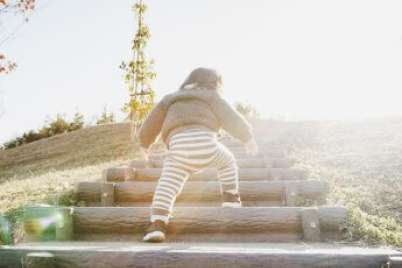
Getting your kids moving: An age-by-age guide
Physical activity comes naturally to kids. From skipping and hopping to wiggling and dancing, they start moving at a very young age. Encouraging your kids to move helps them develop their love of being active. And a key is knowing what kinds of activities are age-appropriate for your little ones.
This guide will help you determine what types of activities you can do with your child to get involved in their love of movement. You never know, you might find yourself skipping, hopping, and shimmying more yourself.
Babies: Age 0-2 years
The best way for babies to get moving is through play. Activities for this age group include any type of play that encourages reaching, rolling, crawling, sitting up, pulling up, and eventually walking.
Encourage movement through:
- Tummy time—Find some great tips on how to do it here [PDF].
- Baby playtime—This would be anything that helps encourage young babies to reach, grasp, or kick [PDF]. Look for toys that have a variety of textures and make sounds to interest your baby.
- Pulling toys—When your baby gets old enough to sit up, a new world opens up. Try attaching a string or shoelace to your baby’s favourite toy and encourage your little one to give it a tug.
- Moving over textures—As they start to crawl or scoot, put a variety of soft textures on the ground for them to move over. They’ll be interested in exploring while they move.
Infants under the age of one should always be supervised during indoor and outdoor physical activities—especially when engaged in interactive floor-based play.
Toddlers and preschoolers: Age 2-4 years
By having toddlers and preschoolers participate in activities that take place in different environments, both indoors and outdoors, they can develop their movement skills and physical literacy. Activities for this age group include everything from moving around the home, climbing stairs, and dancing to playing outside, exploring the environment, running, and even learning to ride a bike!
Encourage movement through:
- Daily movement—Walk as much as you can to your destinations, or around your environment.
- Learning to ride a bike—When they’re ready, let them learn to ride a tricycle, balance bike, scooter or two-wheeler bike (with or without training wheels). Just be sure to supervise.
- Chasing—Have your kids chase bubbles, a kite, a pull toy, or even you!
- Playing fun games—A few examples are Keep the Balloon Up, Puddle Jumping, Simon Says, and more. Find 49 great examples here.
Children: Age 5+
By age five, kids can engage in more energetic play, and the older they get, the more of it they need. Activities for this group include play and challenges that encourage running, hopping, jumping, skipping, bike riding, and more.
Encourage movement through:
- Obstacle courses—Set one up indoors or outdoors and watch them go wild! Here’s how to DIY your own.
- Energetic games—These could be games of tag, skipping rope, follow the leader, musical chairs, or even races.
- Organized sports or activities—This is a good time to introduce quality sports and activities. You can try anything and everything that your kids show an interest in, from soccer, baseball, or hockey to dance, karate, rock climbing, or track. Try a mix of many!
The key is to make it fun and your children will learn to love being active and being on the move each and every day. Need more ideas? Browse through our activities section for easy ideas you can do at home or outside.
Further reading:
How to help your infant develop movement skills
Setting up baby’s environment: 5 tweaks that encourage movement





